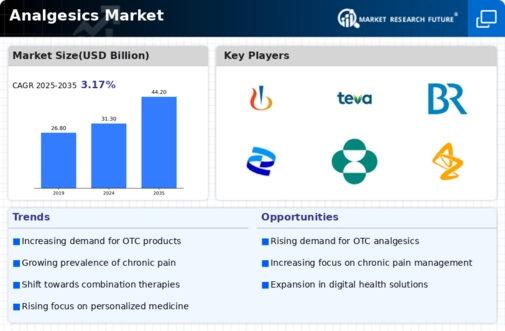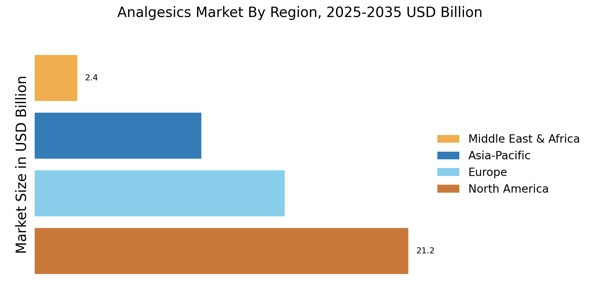Advancements in Drug Development
Innovations in drug development are significantly influencing the Analgesics Market. The emergence of novel analgesics, including non-opioid alternatives and targeted therapies, is reshaping treatment paradigms. Recent advancements in biotechnology and pharmacogenomics have enabled the creation of more effective and safer pain relief options. For instance, the development of monoclonal antibodies and gene therapies shows promise in managing pain with fewer side effects. Market data indicates that the analgesics segment is expected to witness a compound annual growth rate of approximately 5% over the next few years, driven by these advancements. As research continues to evolve, the introduction of new analgesic agents is likely to enhance treatment outcomes and expand market opportunities.
Rising Incidence of Chronic Pain
The increasing prevalence of chronic pain conditions is a primary driver of the Analgesics Market. Conditions such as arthritis, fibromyalgia, and neuropathic pain are becoming more common, affecting millions of individuals worldwide. According to recent estimates, nearly 20% of adults experience chronic pain, which necessitates effective pain management solutions. This growing patient population is likely to propel demand for analgesics, as healthcare providers seek to alleviate suffering and improve quality of life. Furthermore, the aging population, which is more susceptible to chronic pain, contributes to this trend. As a result, pharmaceutical companies are focusing on developing innovative analgesic formulations to cater to this expanding market segment.
Shift Towards Preventive Healthcare
The shift towards preventive healthcare is emerging as a significant driver of the Analgesics Market. As healthcare systems increasingly prioritize preventive measures, there is a growing emphasis on managing pain before it becomes chronic. This proactive approach encourages the use of analgesics not only for treatment but also for prevention in at-risk populations. Market data indicates that preventive analgesics are gaining traction, particularly in surgical and post-operative settings. By addressing pain early, healthcare providers aim to reduce the long-term impact of pain on patients' lives. This trend is likely to create new opportunities for analgesic manufacturers, as they develop products tailored to preventive care strategies.
Growing Awareness of Pain Management
There is a notable increase in awareness regarding pain management strategies, which is positively impacting the Analgesics Market. Educational initiatives by healthcare organizations and advocacy groups are informing patients and providers about the importance of effective pain management. This heightened awareness is leading to more patients seeking treatment for their pain conditions, thereby driving demand for analgesics. Additionally, the integration of pain management into primary care practices is becoming more prevalent, as healthcare professionals recognize the need for comprehensive pain management approaches. Market analysis suggests that this trend could lead to a substantial increase in analgesic prescriptions, further fueling market growth.
Regulatory Support for Pain Management
Regulatory bodies are increasingly recognizing the importance of effective pain management, which is fostering growth in the Analgesics Market. Initiatives aimed at improving access to pain relief medications are being implemented, with guidelines encouraging the use of analgesics in various clinical settings. For example, recent policy changes have streamlined the approval process for new analgesic drugs, facilitating quicker access to innovative treatments. This regulatory support is likely to enhance market dynamics, as pharmaceutical companies are encouraged to invest in research and development of new analgesics. Consequently, the market is expected to expand as more effective pain management solutions become available to healthcare providers and patients.


















Leave a Comment